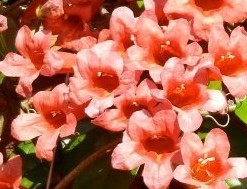 There are many beautiful perennial native vines that can be useful in the garden. They can be used as a screen, to stabalize an embankment, add a vertical element to a flower border, or to adorn a wall, mailbox, or pergola. Vines provide protection and food for wildlife and nesting sites for some birds. Some vines are herbaceous and die down every winter, others are woody and remain above ground with or without leaves. Flowering vines that are evergreen are especially valuable in winter but are more difficult to find and if you live in USDA zone 7 or colder your options are limited. Some vines like Carolina jasmine are root hardy in zone 6 but their stems and leaves die back in winter so their evergreen nature and early spring bloom can not be enjoyed. When selecting vines for your garden look at those in your neighborhood that are doing well and fullfilling the need that you have. You will then have a good idea of what will work best for you.
There are many beautiful perennial native vines that can be useful in the garden. They can be used as a screen, to stabalize an embankment, add a vertical element to a flower border, or to adorn a wall, mailbox, or pergola. Vines provide protection and food for wildlife and nesting sites for some birds. Some vines are herbaceous and die down every winter, others are woody and remain above ground with or without leaves. Flowering vines that are evergreen are especially valuable in winter but are more difficult to find and if you live in USDA zone 7 or colder your options are limited. Some vines like Carolina jasmine are root hardy in zone 6 but their stems and leaves die back in winter so their evergreen nature and early spring bloom can not be enjoyed. When selecting vines for your garden look at those in your neighborhood that are doing well and fullfilling the need that you have. You will then have a good idea of what will work best for you.
The vines below are all perennials that have conspicuous flowers,are hardy in zones 6 and warmer, and provide winter interest with either leaves or stems.
Climbing Hydrangea (Decumaria barbara)
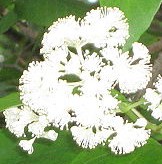 This deciduous vine is native to southeastern US and can be used as a ground cover or climber. It climbs by attaching rootlets and has smooth, shiny, oval to round dark green leaves. The small white fragrant flowers are produced from May to October in flat-topped terminal clusters two to three inches wide but only on vines that are climbing.
This deciduous vine is native to southeastern US and can be used as a ground cover or climber. It climbs by attaching rootlets and has smooth, shiny, oval to round dark green leaves. The small white fragrant flowers are produced from May to October in flat-topped terminal clusters two to three inches wide but only on vines that are climbing.
Height: 30′
Light: Part shade
Soil:Average, moist, well-drained
Hardiness: Zones 6-8
Coral Honeysuckle (Lonicera sempervirens)
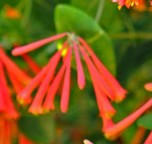 This deciduous, vigorous, native vine is evergreen in the southern part of its range and climbs by twining. In early spring it produces whorled clusters of trumpet shaped flowers 1.5 to 2″ long that are yellow on the inside and red on the outside. The paired leaves are oval and bluish green. The flowers attract hummingbirds, bees, and butterflies, and the fruits provide food for birds.
This deciduous, vigorous, native vine is evergreen in the southern part of its range and climbs by twining. In early spring it produces whorled clusters of trumpet shaped flowers 1.5 to 2″ long that are yellow on the inside and red on the outside. The paired leaves are oval and bluish green. The flowers attract hummingbirds, bees, and butterflies, and the fruits provide food for birds.
Height: 10-20
Light: Full sun to part shade
Soil: Rich, medium moist, well-drained (but tolerates wet soil for short periods.)
Hardiness: Zones 4-8
Crossvine (Bignonia capreolata)
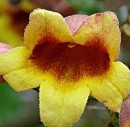 Native to central and southeastern US, this semi-evergreen vine has a woody stem and climbs by tendrils. The glossy dark green leaves are four to six inches long by two inches wide and are produced at the ends of the vines leaving bear stems below. The trumpet shaped flowers are two inches long and produced in clusters of two to five. They appear in spring, may be yellow, orange, or red, and are attractive to hummingbirds. The seed pods that follow are six to eight inches long and dark brown. Many very attractive cultivars are available. Crossvine spreads by means of stolons and can become invasive. The common name crossvine comes from the cross like arrangement of the phloem tissue in the cross section of the stem.
Native to central and southeastern US, this semi-evergreen vine has a woody stem and climbs by tendrils. The glossy dark green leaves are four to six inches long by two inches wide and are produced at the ends of the vines leaving bear stems below. The trumpet shaped flowers are two inches long and produced in clusters of two to five. They appear in spring, may be yellow, orange, or red, and are attractive to hummingbirds. The seed pods that follow are six to eight inches long and dark brown. Many very attractive cultivars are available. Crossvine spreads by means of stolons and can become invasive. The common name crossvine comes from the cross like arrangement of the phloem tissue in the cross section of the stem.
Height: 50′
Light:Full sun (tolerate some shade but bloom poorly)
Soil: Average, medium moist, well-drained (tolerte drought once established)
Hardiness: Zones 3-9
Outstanding Selections:
‘Dragon Lady’ (ruby-red flowers; leaves turn purple in winter)
‘Tangerine Beauty’ (Tangerine petals with yellow center)
Trumpet Creeper (Campsis radicans)
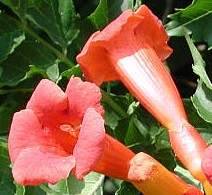 Trumpet creeper is a semi-deciduous or deciduous vine native to southeastern US that has naturalized elsewhere and become a problem in many places. It is a very vigorous plant and climbs by twining stems and rootlets. The leaves are compound and have seven to eleven leaflets. Each leaflet is toothed and two to three inches long. The summer blooming flowers are tube-like and carried in clusters of five or more. They are orange to red and attract hummingbirds and butterflies. Seed pods are up to four inches long and contain winged seeds. Several good cultivars are available.
Trumpet creeper is a semi-deciduous or deciduous vine native to southeastern US that has naturalized elsewhere and become a problem in many places. It is a very vigorous plant and climbs by twining stems and rootlets. The leaves are compound and have seven to eleven leaflets. Each leaflet is toothed and two to three inches long. The summer blooming flowers are tube-like and carried in clusters of five or more. They are orange to red and attract hummingbirds and butterflies. Seed pods are up to four inches long and contain winged seeds. Several good cultivars are available.
Height: 25-40
Light: Full sun (tolerates shade but flowering suffers)
Soil: Lean to average, wet to dry
Hardiness: Zones 5-9
Virgins Bower (Clematis virginiana)
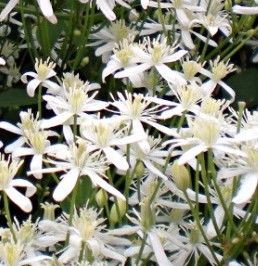 Also called woodbine, this deciduous climber is native to eastern US. It is a vigorous plant and climbs by twisting its stems and petioles around other plants. The leaves are compound with three to five toothed leaflets and are almost covered in late summer to fall by masses of small white fragrant flowers carried in axillilary panicles. Male and female flowers are found on different plants and the female flowers produce attractive seed heads that provide additional interest in the garden.
Also called woodbine, this deciduous climber is native to eastern US. It is a vigorous plant and climbs by twisting its stems and petioles around other plants. The leaves are compound with three to five toothed leaflets and are almost covered in late summer to fall by masses of small white fragrant flowers carried in axillilary panicles. Male and female flowers are found on different plants and the female flowers produce attractive seed heads that provide additional interest in the garden.
Height: 12-20′
Light: Sun, part shade, shade
Soil: Average, medium moist, well-drained
Hardiness: Zones 6-8
Wisteria
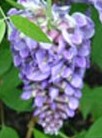 Two kinds of wisteria are native to the US: American wisteria (Wisteria frutescens ) and Kentucky wisteria (W. macrostachya), Both are very similar to each other; they are deciduous twining vines with pinnately compound dark green shiny leaves and and pea-like blue-purple flowers produced in dense racemes in early summer. The flowers of W. macrostachya, however, are fragrant while those of W. frutescens are not. They differ from their Asian cousins by having shorter flowering racemes and being less aggressive.
Two kinds of wisteria are native to the US: American wisteria (Wisteria frutescens ) and Kentucky wisteria (W. macrostachya), Both are very similar to each other; they are deciduous twining vines with pinnately compound dark green shiny leaves and and pea-like blue-purple flowers produced in dense racemes in early summer. The flowers of W. macrostachya, however, are fragrant while those of W. frutescens are not. They differ from their Asian cousins by having shorter flowering racemes and being less aggressive.
Height: American, 15-25′; Kentucky, 15-25′
Light: Full sun
Soil:Fertile, medium moist, well-drained
Hardiness: American ,Zones 5-9; Kentucky, Zones 3-9